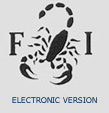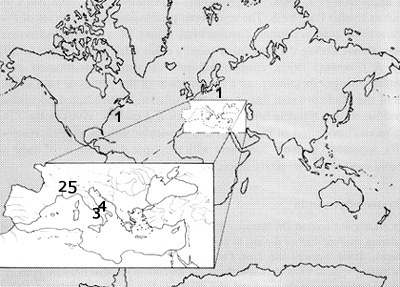 |
 CHECKLIST DELLE SPECIE DELLA FAUNA ITALIANA. COPEPODA Calderini ed. Italy - 1995 and to the CHECKLIST OF THE SPECIES OF THE ITALIAN FAUNA by F. Stoch (http://www.faunaitalia.it/checklist/) |
 |
 CHECKLIST DELLE SPECIE DELLA FAUNA ITALIANA. COPEPODA Calderini ed. Italy - 1995 and to the CHECKLIST OF THE SPECIES OF THE ITALIAN FAUNA by F. Stoch (http://www.faunaitalia.it/checklist/) |
|
Family Ectinosomatidae Sars, 1903
The family Ectinosomidae was established by Sars (1904) and later discussed in a very detailed manner by Olofsson (1917), who also provided a key to five, in that time known, genera. The family name was corrected to Ectinosomatidae by Moore (1978), according to the International Code of Zoological Nomenclature. Systematic changes on a family level
were made only by Lang (1944, 1948, 1965) who also provided very useful keys to genera, 10 in 1948 and 14 in 1965. At present the family Ectinosomatidae encompasses about 232 species and
subspecies, grouped into 19 valid genera (Bodin, 1997): Arenosetella Wilson, 1932; Bradya
Boeck, 1972; Bradyellopsis Brian, 1924; Ectinosoma Boeck, 1865; Halectinosoma Lang, 1944;
Halophytophilus Brian, 1917; Hastigerella Nicholls, 1935; Klieosoma Hicks & Schriever,
1985; Lineosoma Wells, 1965; Microsetella Brady & Robertson, 1873; Noodtiella Wells, 1965;
Pseudectinosoma Kunz, 1935; Pseudobradya Sars, 1904; Sigmatidium Giesbrecht, 1881;
Ectinosomella Sars, 1910; Ectinosomoides Nicholls, 1945; Oikopus Wells, 1967; Peltobradya
Medioni & Soyer, 1967; and Tetanopis Brady, 1910. Last five genera are monospecific, while the
genus Bradya is subdivided into two subgenera: Bradya s. str. and Parabradya Lang, 1944.
Only the genus Pseudectinosoma includes exclusive freshwater species;all the other genera are marine,
with just a few freshwater species. Lang (1965) pointed out two distinct evolutionary lineages
within the family Ectinosomatidae: one comprising genera with rectangular cephalothorax
and linear body shape, the other with a cephalothorax gradually attenuated in front and
fusiform body shape.
Boeck (1865) established the genus Ectinosoma with the type-species E. melaniceps Boeck, 1865. Lang (1948) split the genus into the subgenera Halectinosoma, including species of Ectinosoma with one surface seta and 3 distal setae exopod P5, Ectinosoma embracing species with 4 distal setae exopod P5. In 1965 Lang "looked upon them as separate genera ... , since no transitional forms can exist between them ...". but sometimes it is difficult to decide whether there is a surface seta or not, as shown in the case of Halectinosoma porosum Wells, 1967. This species has a very peculiar P5, because the exopod is completely fused with the baseoendopod and there is no real surface seta but a seta on a lobule in distal position. This species shows pores on the cephalothorax that resemble the characteristic ushaped tubercles that can be found only in the Ectinosoma species. For this reason, H. porosum has to be transferred to the genus Ectinosoma. Lang (1965) pointed out that tubercles can probably be found in all species of the genus Ectinosoma and that "pores of the very same appearance occur on all somites, the penultimate one excepted." Except E. soyeri Apostolov, 1975, all species of Ectinosoma have been shown to possess a tubercle on exopod P5. Most species are also reported to have tubercles on the abdomen or the whole body.
The species of Halectinosoma, the sister group of Ectinosoma, have little round inconspicuous pores instead of tubercles.
At the moment it is very difficult to determine Ectinosoma species. Very often there are no differences in the number of setae of the appendages and the distinctive features are very small. The drawings frequently are not good enough or lacking. As Lang (1965) pointed out, the mandible carries very good diagnostic characters. The cutting edge is unique for a species in most cases. Unfortunately, the mandible is often not mentioned in the description. Mielke (1979) showed that characters of the antenna, female P5, male P5-P6, and the ornamentation of the abdominal somite reveal distinctive features. These become apparent when detailed descriptions are available. This also holds for the ornamentation of the body. The presence, number and distribution of rows of fine cuticular hairs, tubercles, sensillae and the shape of hyaline frills are constant in a species and provide many useful characters which can be seen in whole specimens without dissection. The form of the labrum also seems to be useful in distinguishing between the species, as in the case of E. papuarum and E. barbararum. At present the genus Ectinosoma includes 29 valid species and some species incertae.
(after Seifried, 1997).
WORLD CHECKLIST OF THE GENUS ECTINOSOMA AT [COPEPODS WEB PORTAL]
The genus Halectinosoma is the largest in the family Ectinosomatidae, currently encompassing 57 valid species. Initially it was described as a subgenus of the genus Ectinosoma, with the following short diagnosis (Lang, 1944): "Exp. P.5 mit 3 Rand- and 1 Flachenborste, welch letztere evtl. fehlen kann." Exactly the same was repeated later (Lang, 1948), but unfortunately Lang too omitted to designate the type species. This was done by Vervoort (1962), who designated Ectinosoma sarsi Boeck, 1872. Lang (1965) erected Halectinosoma at generic level, although he did not mention Vervoort's designation of the type species. Unfortunately Halectinosoma sarsi (Boeck, 1972) was placed as incertae sedis by Clement & Moore (1995), so the genus is
now without the type species. Lang's (1944, 1948) division of Halectinosoma into the "sarsi"group (where the third exopodite segment of second, third and fourth swimming legs carried 3 outer spines) and the "curticorne"-group (where the third exopodite segment of at least fourth swimming leg bore 2 outer spines) was later (Lang, 1965) considered unworkable. Although the detailed morphology is quite conservative within the genus some of its species have obviously been misplaced and should be referred to other genera. One of them, H. porosum Wells, 1967, was formally transferred to the genus Ectinosoma by Huys & Bodin (1997); some other probably belong to yet undescribed genera. However, the systematic of the genus Halectinosoma is problematic and species identification is very difficult due to the inadequacy of most of the descriptions in the literature (Clement & Moore, 1995). This genus is indeed much closer to the genus Pseudobradya than to Ectinosoma, from which it was properly divided. One of the characters that is traditionally used to distinguish Halectinosoma from Pseudobradya is the condensed maxillary endopodite in the former (Huys & Bodin, 1997). Also, a position of the inner setae on the maxillary basis can be used as a very good distinguishing character between these two genera (they are always situated near the top of the basis in Pseudobradya). Probably the subgeneric status of Halectinosoma (of the genus Pseudobradya) could be more appropriate, but its generic status should be retained because it has already been the subgenus (of the genus Ectinosoma) and this could cause great taxonomic confusion.
WORLD CHECKLIST OF THE GENUS HALECTINOSOMA AT [COPEPODS WEB PORTAL]
Kunz (1935) created the genus Pseudectinosoma to accomodate harpacticoids from benthic biotopes of Kiel Bay (Germany) close to Sigmatidium Giesbrech, 1881. Pseudectinosoma is a poorly diversified genus among the Ectinosomatidae, its geographical distribution suggesting on ancient origin (Galassi, 1997; Galassi & De Laurentiis, 1997). 
Distribution of the genus Pseudectinosoma (after Galassi, 1997 mod.):
Micosetella norvegica (Boeck, 1864) 3, 4, 5
Pseudobradya pygmaea G.O. Sars, 1904 4
Halophytophilus fusiformis Brian, 1917 3
Arenosetella germanica Kunz, 1937 3
|